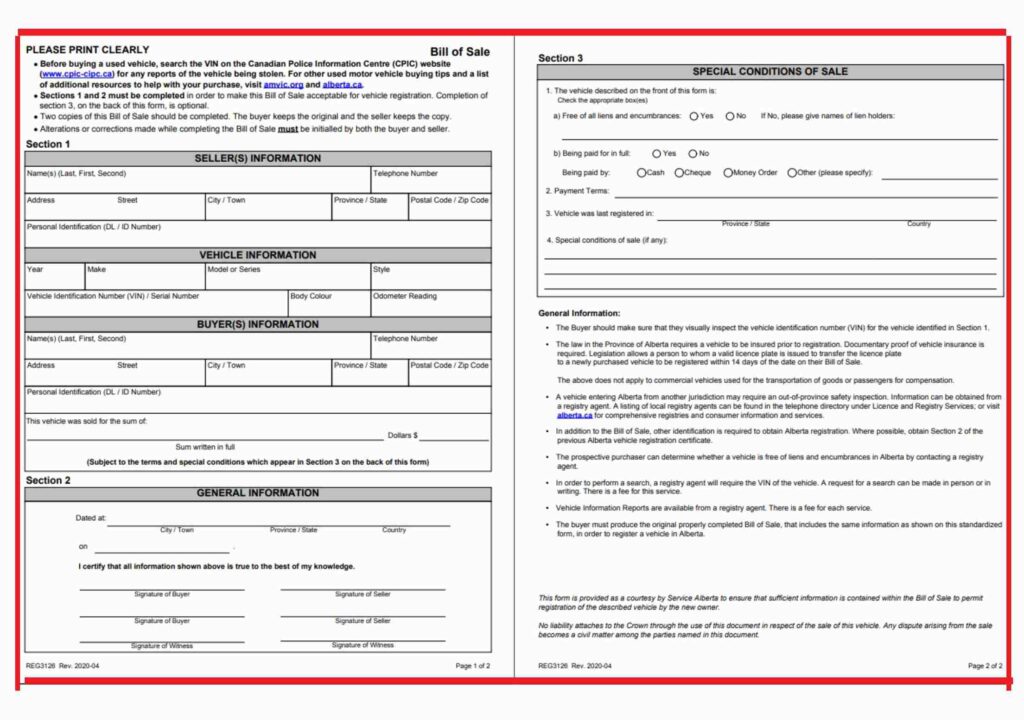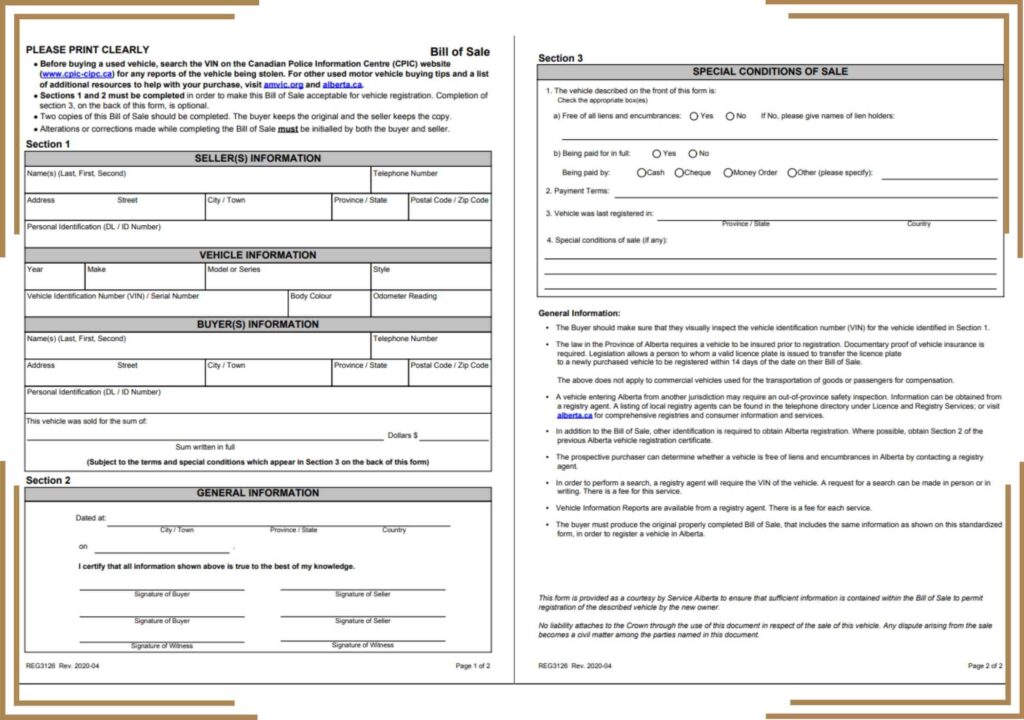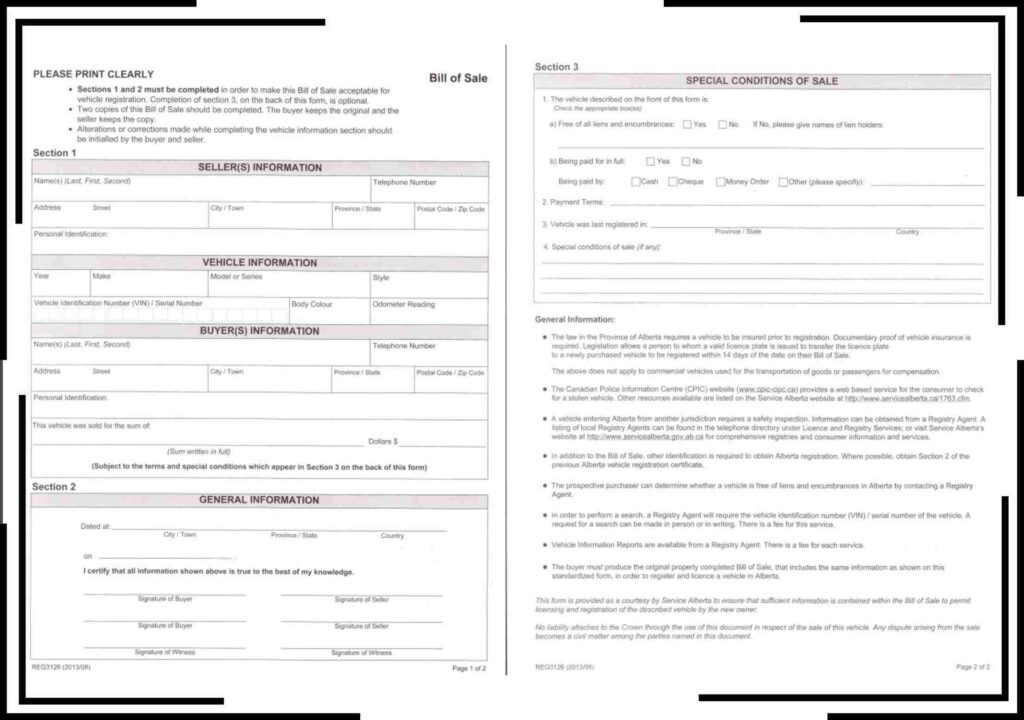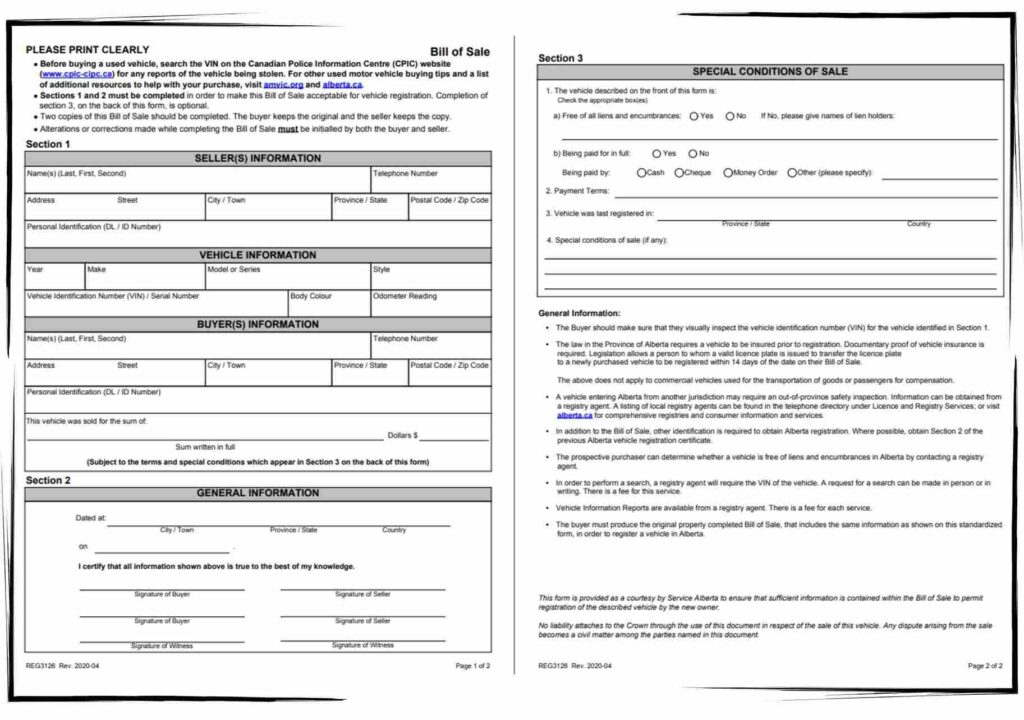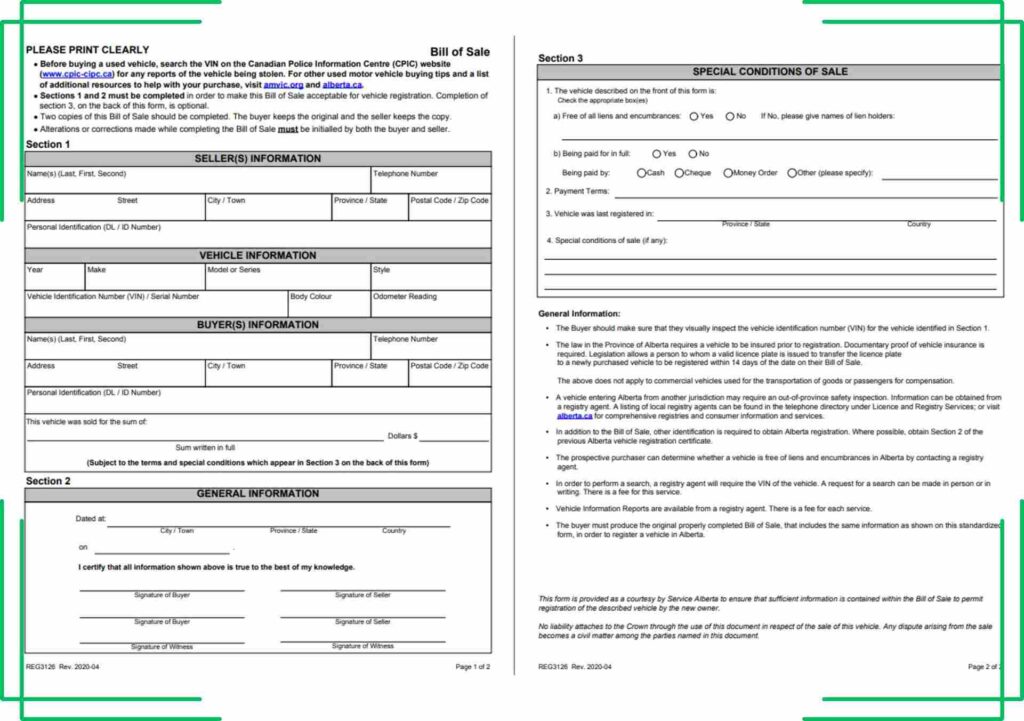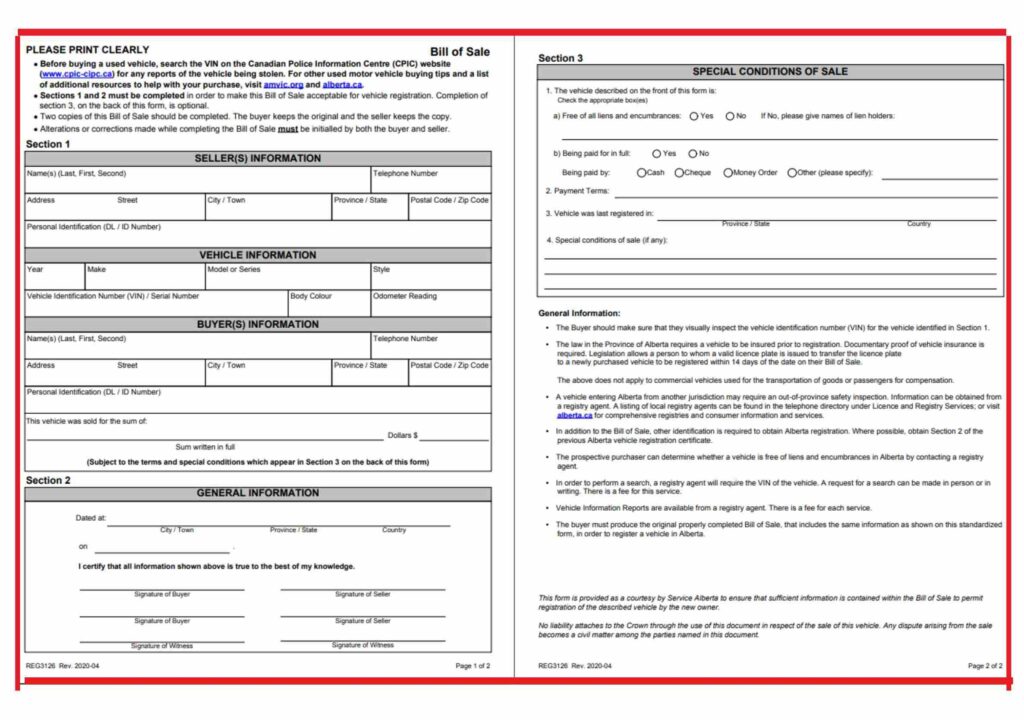Printable Alberta Bill Of Sale Canada [Free Templates]
The Alberta Bill of Sale is a vital legal document used to record the transfer of ownership between a seller and a buyer. It outlines the details of the sale, including the parties involved, a description of the item sold, the purchase price, and any terms or conditions agreed upon. In essence, it transfers ownership of the item from the seller to the buyer and provides a record of the transaction.
In Alberta, a Bill of Sale is highly significant for several reasons. Firstly, it acts as official documentation of the transfer of ownership, which can be crucial for establishing ownership rights and resolving disputes in the future. This is particularly important for high-value items such as vehicles, real estate, or valuable assets.
Secondly, a Bill of Sale is often required for legal and administrative purposes. For example, when registering a newly purchased vehicle with the Alberta Motor Vehicle Registry, a Bill of Sale is typically required to prove ownership. Similarly, when dealing with insurance claims or taxation matters, a Bill of Sale can serve as essential documentation.
Also, We have included all the things you need to write a bill of sale, including a downloadable PDF, what to include and what are your next steps when completing a bill of sale.
Free Printable Alberta Bill of Sale Template
Alberta Vehicle Bill of Sale
Alberta Vehicle Bill of Sale is legally required for transferring vehicle ownership within Alberta, Canada, from a seller to a buyer. It acts as a formal record of the sale and facilitates the official transfer of ownership.
Key Details of Alberta Vehicle Bills of Sale:
- Mandatory for private motor vehicle sales, covering cars, trucks, motorcycles, and registered motorized vehicles.
- Includes essential information like sale date, seller and buyer details, vehicle description, VIN, odometer reading, and sale price.
- Obtainable through downloadable templates, legal websites, software programs, or pre-printed forms.
- Important to ensure template validity, accurate completion, signatures from all parties, and reporting to the Alberta Motor Vehicle Registry.
Not required for dealership purchases, and a title search is recommended for checking liens or encumbrances.
Alberta Auto Bill of Sale
An Alberta Auto Bill of Sale is crucial for private vehicle transactions in the province, serving as a legal record that transfers ownership from seller to buyer. It’s compulsory for cars, trucks, motorcycles, and all registered motorized vehicles. This guide highlights key details needed:
- Date of Sale
- Seller and Buyer Information
- Vehicle Description
- Sale Price
You can obtain it through templates, legal websites, software, or pre-printed forms. Ensure accuracy, signatures from both parties, and timely reporting to the Alberta Motor Vehicle Registry. Remember, a Bill of Sale doesn’t guarantee freedom from liens, so conduct a title search for a clear transaction.
Alberta Bill of Sale For Vehicle
The Alberta Bill of Sale for Vehicle is crucial in private motor vehicle sales, serving two vital roles:
- Records the Sale: Officially transfers ownership from the seller to the buyer.
- Provides Legal Protection: Safeguards both parties in case of disputes or legal issues.
Key details in a valid Alberta Bill of Sale for Vehicle include:
- Sale Date
- Seller and Buyer Information
- Vehicle Description
- Sale Price
Acquire it through free templates, legal websites, software programs, or pre-printed forms. Ensure accuracy, signatures, and reporting to the Alberta Motor Vehicle Registry post-sale. Note that it doesn’t guarantee lien-free vehicles, necessitating a title search for a clear title.
Alberta Motor Vehicle Bill of Sale
The Alberta Motor Vehicle Bill of Sale is crucial in private vehicle sales, ensuring lawful ownership transfer. Mandatory for cars, trucks, motorcycles, it offers:
- Official Record: Clearly documents ownership transfer.
- Legal Protection: Guards against disputes or legal issues.
- Proof of Ownership: Acts as initial ownership proof.
Key details include sale date, seller and buyer info, vehicle description, and sale price. Obtain through AMA templates, legal websites, software programs, or pre-printed forms. Ensure template validity, accurate completion, and signatures. After sale, sellers report to AMVR, buyers register using the Bill. Not needed for dealership purchases, doesn’t guarantee lien-free status.
Alberta Bill of Sale PDF
Automobile Bill of Sale Alberta
In Alberta, Canada, an Automobile Bill of Sale holds significant legal importance whenever a motor vehicle is privately sold. It acts as a crucial record of the transaction, providing protection for both the buyer and seller during the transfer of ownership process.
Why is it Crucial?
An Automobile Bill of Sale is obligatory for any private sale involving cars, trucks, motorcycles, or other motorized vehicles registered with the Alberta Motor Vehicle Registry (AMVR). It offers several key advantages:
- Official Record: It officially documents the sale, establishing the transfer of ownership from the seller to the buyer.
- Legal Protection: The Bill of Sale provides legal protection for both parties in potential future disputes or legal matters related to the sale.
- Proof of Ownership: For the buyer, it acts as initial proof of ownership when registering the vehicle under their name.
What Does it Include?
A valid Alberta Automobile Bill of Sale should include these essential details:
- Sale Date: Indicates the date of ownership transfer.
- Seller Information:
- Full legal names and addresses of all sellers.
- Signatures of each seller.
- Buyer Information:
- Full legal names and addresses of all buyers.
- Signatures of each buyer.
- Vehicle Description:
- Make, model, and year of the vehicle.
- Vehicle Identification Number (VIN).
- Odometer reading at the time of sale.
- Optional but recommended: Vehicle color and body style for additional clarity.
- Sale Price: The agreed-upon purchase price for the vehicle.
How to Obtain an Automobile Bill of Sale:
There are several methods to acquire an Alberta Automobile Bill of Sale:
- Free Downloadable Templates: Utilize the Alberta Motor Association (AMA) website for a free downloadable Bill of Sale template specific to Alberta vehicles.
- Legal Information Websites: Access free printable Bill of Sale templates from reputable legal information websites, ensuring they are Alberta-specific and comply with legal requirements.
- Software Programs: Some software programs offer Alberta-specific templates and guide you through creating Bills of Sale.
- Pre-printed Forms: Purchase pre-printed Bill of Sale forms designed for Alberta from stationery or office supply stores.
Important Considerations:
- Template Validity: Ensure the chosen Bill of Sale template is current and complies with Alberta’s legal requirements.
- Accurate Completion: Fill out the Bill of Sale accurately and completely with all necessary information.
- Signatures: Both the buyer(s) and seller(s) must sign and date the Bill of Sale for validity.
- Multiple Parties: If multiple sellers or buyers are involved, ensure all parties sign the Bill of Sale.
Post-Sale Responsibilities:
- Seller’s Duty: Report the sale to the AMVR within 10 days of completion, either online or in person.
- Buyer’s Duty: Register the vehicle under their name with the AMVR, providing the Bill of Sale, proof of insurance, and applicable fees.
Additional Notes:
- A Bill of Sale is not required for dealership vehicle purchases as the dealership handles ownership transfer.
- An Alberta Automobile Bill of Sale does not guarantee the absence of liens or encumbrances. Conduct a title search before finalizing the purchase for a clear title.
By recognizing the significance of an Automobile Bill of Sale in Alberta and ensuring its accurate completion, you contribute to a smooth and legally valid transfer of vehicle ownership.
Alberta Registries Bill of Sale
The term “Alberta Registries Bill of Sale” isn’t commonly used. In Alberta, Canada, the relevant government body for vehicle registration is the Alberta Motor Vehicle Registry (AMVR), not Alberta Registries.
However, the concept of a Bill of Sale remains crucial for private vehicle sales in Alberta. Here’s a detailed breakdown of what you need to know:
Bill of Sale for Vehicles in Alberta
Requirement: An Alberta Bill of Sale (also referred to as Automobile Bill of Sale or Motor Vehicle Bill of Sale) is mandatory for any private sale involving cars, trucks, motorcycles, or any other motorized vehicle registered with the AMVR.
Purpose: It serves as a legal document that records the sale and transfers ownership from the seller to the buyer.
Benefits:
- Provides an official record of the transaction.
- Offers legal protection for both parties in case of future disputes.
- Acts as initial proof of ownership for the buyer during vehicle registration.
Obtaining a Bill of Sale:
- Free Downloadable Templates: The Alberta Motor Association (AMA) offers a free downloadable Bill of Sale template specifically designed for vehicles in Alberta AMA Bill of Sale.
- Legal Information Websites: Various legal information websites offer free printable Bill of Sale templates. Ensure the template is specifically designed for Alberta and meets current legal requirements.
- Software Programs: Some software programs allow you to create Bills of Sale, providing Alberta-specific templates and guiding you through the completion process.
- Pre-printed Forms: Stationery stores or office supply stores may sell pre-printed Bill of Sale forms designed for Alberta.
Important Considerations:
- Template Validity: Ensure the chosen Bill of Sale template is up-to-date and complies with current legal requirements in Alberta.
- Accurate Completion: Fill out the Bill of Sale accurately and completely with all required information.
- Signatures: Both the buyer(s) and seller(s) must sign and date the Bill of Sale for it to be valid.
- Multiple Parties: If multiple sellers or buyers are involved, all parties must sign the Bill of Sale.
After the Sale:
- Seller’s Responsibilities: Report the sale to the AMVR within 10 days after completion, either online or in person.
- Buyer’s Responsibilities: Register the vehicle in their name with the AMVR, providing the Bill of Sale, proof of insurance, and applicable fees.
Additional Notes:
- A Bill of Sale is not required for dealership vehicle purchases as the dealership manages the ownership transfer process.
- An Alberta Bill of Sale does not guarantee the absence of liens or encumbrances. Perform a title search before finalizing the purchase for a clear title.
By understanding the importance of a Bill of Sale for vehicles in Alberta and ensuring its proper completion, you contribute to a smooth and legally sound transfer of vehicle ownership.
FAQ
Here’s a guide on how to write a Bill of Sale for a vehicle:
Information to Include:
A valid Bill of Sale should include the following essential details:
- Title: Clearly label the document as “Bill of Sale” at the top.
- Date of Sale: The date the ownership of the vehicle is transferred.
- Seller Information:
- Full legal names and addresses of all sellers involved in the transaction.
- Signatures of each seller.
- Buyer Information:
- Full legal names and addresses of all buyers involved in the transaction.
- Signatures of each buyer.
- Vehicle Description:
- Make, model, and year of the vehicle.
- Vehicle Identification Number (VIN).
- Odometer reading at the time of sale.
- Vehicle colour and body style (optional but recommended for additional clarity).
- Sale Price: The agreed-upon purchase price for the vehicle (written in both numbers and words for clarity).
- “As-Is” Clause (Optional, but Recommended): This clause states that the vehicle is being sold “as-is” and the seller makes no warranties or guarantees about its condition. You can find sample wording online or consult a lawyer for specific phrasing.
Structuring the Bill of Sale:
Here’s a possible structure for your Bill of Sale:
- Title: Bill of Sale
- Body:
- This Bill of Sale is made and entered into on this [Date of Sale], by and between:
- Seller(s): [Full Name(s) and Address(es)] (hereinafter referred to as “Seller”)
- Buyer(s): [Full Name(s) and Address(es)] (hereinafter referred to as “Buyer”)
- This Bill of Sale is made and entered into on this [Date of Sale], by and between:
- In consideration of the foregoing premises and the mutual covenants hereinafter set forth, the parties agree as follows:
- The Seller hereby sells, transfers, and assigns to the Buyer, and the Buyer hereby purchases from the Seller, the following vehicle:
- Year: [Year]
- Make: [Make]
- Model: [Model]
- VIN: [VIN]
- Odometer reading: [Odometer reading]
- Colour: [Colour] (optional)
- Body style: [Body style] (optional)
- Sale Price: [Sale price in numbers] ([Sale price in words])
- The Seller hereby sells, transfers, and assigns to the Buyer, and the Buyer hereby purchases from the Seller, the following vehicle:
- “As-Is” Clause (Optional): Include this clause if applicable.
- Signatures:
- Seller(s) Signature: _______________ Printed Name: _______________
- Buyer(s) Signature: _______________ Printed Name: _______________
Additional Tips:
- Use a clear and concise format.
- Type or write neatly in black ink.
- Make sure both buyer(s) and seller(s) receive a copy of the signed Bill of Sale.
- Consider consulting with a lawyer to ensure your Bill of Sale meets all legal requirements in your area.
Obtaining a Template:
While you can draft your own Bill of Sale, here are some resources to obtain a template:
- The Alberta Motor Association (AMA): (For Alberta, Canada) Offers a free downloadable Bill of Sale template specifically designed for vehicles https://ama.ab.ca/auto/buying-selling/bill-of-sale.
- Legal Information Websites: Various legal information websites offer free printable Bill of Sale templates. Be cautious and ensure the template is specifically designed for your state or province and adheres to current legal requirements.
Remember, a Bill of Sale is a legal document. While these tips can guide you, it’s always best to consult with a lawyer if you have any questions or concerns.
Here’s a guide on how to write a Bill of Sale for various situations (car, furniture, etc.):
Information to Include:
A valid Bill of Sale should include the following essential details:
Title: Clearly label the document as “Bill of Sale” at the top.
Date of Sale: The date the ownership of the item is transferred.
Seller Information:
- Full legal names and addresses of all sellers involved in the transaction.
- Signatures of each seller.
Buyer Information:
- Full legal names and addresses of all buyers involved in the transaction.
- Signatures of each buyer.
Item Description: This will vary depending on what you’re selling. Here are some examples:
- Vehicle: Year, Make, Model, VIN, Odometer reading, Color (optional)
- Furniture: Type of furniture (e.g., couch, table), material (e.g., wood, leather), any distinguishing features (e.g., brand name)
- General: A clear description of the item being sold
Sale Price: The agreed-upon purchase price for the item (written in both numbers and words for clarity).
“As-Is” Clause (Optional, but Recommended): This clause states that the item is being sold “as-is” and the seller makes no warranties or guarantees about its condition. You can find sample wording online or consult a lawyer for specific phrasing.
Structuring the Bill of Sale:
Here’s a possible structure for your Bill of Sale:
- Title: Bill of Sale
- Body:
- This Bill of Sale is made and entered into on this [Date of Sale], by and between:
- Seller(s): [Full Name(s) and Address(es)] (hereinafter referred to as “Seller”)
- Buyer(s): [Full Name(s) and Address(es)] (hereinafter referred to as “Buyer”)
- This Bill of Sale is made and entered into on this [Date of Sale], by and between:
- In consideration of the foregoing premises and the mutual covenants hereinafter set forth, the parties agree as follows:
- The Seller hereby sells, transfers, and assigns to the Buyer, and the Buyer hereby purchases from the Seller, the following item(s):
- [Item Description]
- Sale Price: [Sale price in numbers] ([Sale price in words])
- The Seller hereby sells, transfers, and assigns to the Buyer, and the Buyer hereby purchases from the Seller, the following item(s):
- “As-Is” Clause (Optional): Include this clause if applicable.
- Signatures:
- Seller(s) Signature: _______________ Printed Name: _______________
- Buyer(s) Signature: _______________ Printed Name: _______________
Additional Tips:
- Use a clear and concise format.
- Type or write neatly in black ink.
- Make sure both buyer(s) and seller(s) receive a copy of the signed Bill of Sale.
- Consider consulting with a lawyer to ensure your Bill of Sale meets all legal requirements in your area, especially for high-value items.
Obtaining a Template:
While you can draft your own Bill of Sale, here are some resources to obtain a template:
- Legal Information Websites: Various legal information websites offer free printable Bill of Sale templates. Be cautious and ensure the template is specifically designed for your state and adheres to current legal requirements.
- Car Seller Resources: For vehicles, some car seller resources or your local Department of Motor Vehicles website might offer templates specific to your area.
Remember: A Bill of Sale is a legal document. While these tips can guide you, it’s always best to consult with a lawyer if you have any questions or concerns, especially for high-value items.
A Bill of Sale is a legal document that confirms the transfer of ownership of goods from one party (seller) to another (buyer), providing essential proof of the transaction and safeguarding both parties.
Key Points about Bills of Sale:
Usage:
- Typically used in private sales, excluding dealership transactions.
- Commonly required for vehicles, furniture, animals, and personal property like boats or electronics.
Contents:
- Title: Clearly labeled as “Bill of Sale.”
- Sale Date: Indicates the transfer of ownership date.
- Seller Info: Includes full names, addresses, and signatures of all sellers.
- Buyer Info: Includes full names, addresses, and signatures of all buyers.
- Item Description: Detailed description of the goods, including vehicle specifics like year, make, model, VIN, and odometer reading.
- Sale Price: Agreed purchase price in numerical and written forms.
- “As-Is” Clause (Optional): States the item is sold without warranties or guarantees about its condition.
Benefits:
- Provides a legal record and clarifies ownership transfer.
- Protects both buyer and seller in potential disputes.
- Serves as proof of ownership for buyers during registration (especially for vehicles).
Obtaining a Bill of Sale:
- Free Templates: Legal websites offer printable templates tailored to your location.
- Software Programs: Some software helps create location-specific Bill of Sale forms.
- Pre-printed Forms: Available in stationery or office supply stores.
Considerations:
- Template Validity: Ensure the template meets legal requirements in your area.
- Accurate Completion: Fill out all necessary details accurately.
- Signatures: All involved parties must sign and date the Bill of Sale.
Additional Notes:
- Not usually required in licensed dealership purchases.
- Does not guarantee an item’s freedom from debts; consider a title search for high-value items.
Understanding the importance and process of a Bill of Sale ensures a secure transaction experience in private sales of goods.
Here’s a guide on crafting a Bill of Sale for a car:
Essential Details to Include:
- Title: Clearly label the document as “Bill of Sale” at the top.
- Date of Sale: Indicates the transfer of vehicle ownership date.
- Seller Information:
- Full legal names and addresses of all sellers involved.
- Signatures of each seller.
- Buyer Information:
- Full legal names and addresses of all buyers involved.
- Signatures of each buyer.
- Vehicle Description:
- Year, Make, and Model of the car.
- Vehicle Identification Number (VIN).
- Odometer reading at the time of sale.
- Vehicle color and body style (optional but recommended for clarity).
- Sale Price: Agreed purchase price for the vehicle (written in both numbers and words for clarity).
- “As-Is” Clause (Optional, but Recommended): States that the car is sold “as-is” without warranties or guarantees about its condition. Sample wording can be found online or consult a lawyer for specifics.
Structuring the Bill of Sale:
Here’s a possible structure for your Bill of Sale:
- Title: Bill of Sale
- Body:
- This Bill of Sale is made and entered into on this [Date of Sale], by and between:
- Seller(s): [Full Name(s) and Address(es)] (hereinafter referred to as “Seller”)
- Buyer(s): [Full Name(s) and Address(es)] (hereinafter referred to as “Buyer”)
- This Bill of Sale is made and entered into on this [Date of Sale], by and between:
- In consideration of the foregoing premises and the mutual covenants hereinafter set forth, the parties agree as follows:
- The Seller hereby sells, transfers, and assigns to the Buyer, and the Buyer hereby purchases from the Seller, the following vehicle:
- Year: [Year]
- Make: [Make]
- Model: [Model]
- VIN: [VIN]
- Odometer reading: [Odometer reading]
- Color: [Color] (optional)
- Body style: [Body style] (optional) Sale Price: [Sale price in numbers] ([Sale price in words]) “As-Is” Clause (Optional): Include this clause if applicable. Signatures: Seller(s) Signature: _______________ Printed Name: _______________ Buyer(s) Signature: _______________ Printed Name: _______________
Additional Tips:
- Use a clear and concise format.
- Write or type neatly in black ink.
- Provide copies to both buyer(s) and seller(s) after signing.
- Seek legal advice to ensure compliance with local legal requirements, especially for high-value transactions.
Obtaining a Template:
You can obtain a vehicle-specific Bill of Sale template from:
- The Alberta Motor Association (AMA) website: Offers a free downloadable template for Alberta, Canada https://ama.ab.ca/auto/buying-selling/bill-of-sale.
- Your Local Department of Motor Vehicles (DMV) Website: Some DMV websites provide state or province-specific templates.
Important Reminders:
- Consult a lawyer for any legal concerns, especially for high-value vehicle transactions.
- A Bill of Sale does not guarantee the absence of liens or encumbrances on the vehicle; consider a title search for clarity before finalizing the purchase.
A Bill of Sale in Alberta typically doesn’t necessitate a “personal identification number” akin to a government-issued ID number such as a driver’s license number.
The emphasis of the Bill of Sale lies in identifying the parties engaged in the sale: seller(s) and buyer(s). Here’s what the Bill of Sale should encompass for identification purposes:
- Full legal names of all sellers and buyers involved in the transaction.
- Full addresses of all sellers and buyers involved in the transaction.
Although a driver’s license number is not obligatory on the Bill of Sale itself, having the seller(s) and buyer(s) furnish their full legal names and addresses facilitates proper identification and enhances the document’s validity.
Here’s an overview of what the Bill of Sale typically necessitates for identification:
Seller Information:
- Full legal names of all sellers involved.
- Signatures of each seller.
Buyer Information:
- Full legal names of all buyers involved.
- Signatures of each buyer.
Additional Documents for Vehicle Sale:
While the Bill of Sale identifies the involved parties, other documents may mandate a government-issued ID during the vehicle sale process. Here are potential scenarios:
Vehicle Registration: Transferring vehicle registration with the Alberta Motor Vehicle Registry (AMVR) might entail presenting a valid government-issued ID (such as a driver’s license, passport, etc.) for verification purposes. Proof of Insurance: Both the buyer and seller may need to provide proof of insurance during the sale process. This could involve presenting insurance documents or using the seller’s insurance information temporarily until the buyer obtains their own coverage.
In Summary:
The Bill of Sale itself does not necessitate a government-issued ID number like a driver’s license number. It emphasizes full legal names and addresses for seller and buyer identification. However, throughout the overall vehicle sale process, other documents such as vehicle registration transfer or proof of insurance may require presenting a valid government-issued ID.
